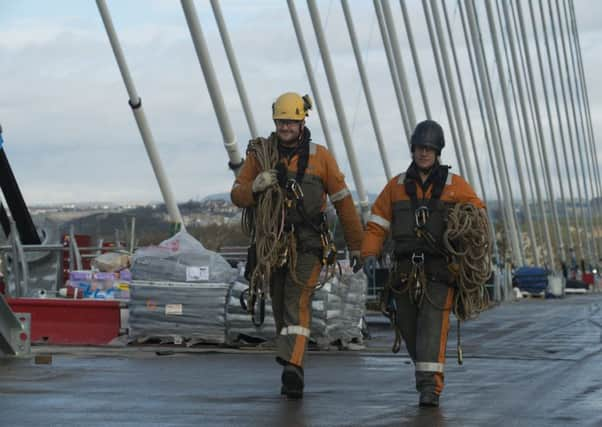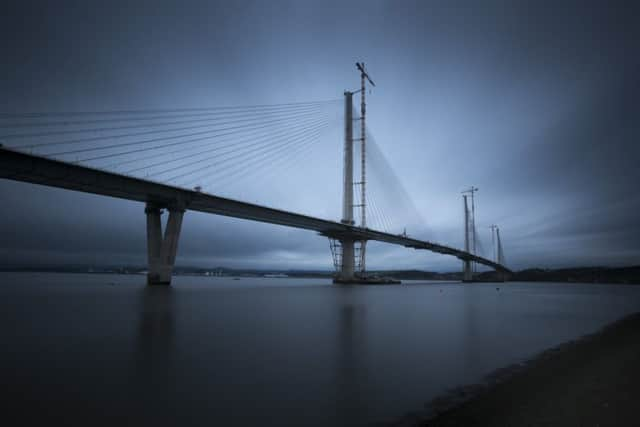View from the bridge: The Queensferry Crossing


For graduate engineer Dave McIntyre, it’s a temporary building a quarter of the way up the UK’s tallest bridge, which is also the largest of its type in the world.
The nearest shop for that forgotten sandwich is not exactly round the corner, with the 25-year-old’s commute from his home in Linlithgow involving taking a barge from Rosyth, followed by an ascent of the Queensferry Crossing’s 683ft towers to deck level.
Advertisement
Hide AdAdvertisement
Hide AdMcIntyre now takes precautions against midday starvation. “I’ve only done it once. You just have to beg, borrow or steal. I now have a bit of a stockpile – tins of soup and fruit.”


For the 1,300-strong workforce, some of whom have laboured for more than five years on the project, food is as much of a logistical priority as any other component being brought in as the bridge takes shape.
Pizza is the favoured nosh – because it’s easy to eat – so that means huge orders from Domino’s Pizza, which have been lifted on to the bridge by crane, 44 at a time. Remarkably, they are said to have still been warm on arrival.
Such simple pleasures, washed down with a warming tea or coffee, are what keep the workers going during jobs where there is no let-up until they are finished.
General foreman Columba Cannon, who is responsible for a team of up to 60, remembers days when pouring concrete meant working virtually non-stop from 8am to 11pm.


“That was one of the toughest times. It was blowing quite strong and it was cold. When you are in that situation, you just crack on with it. You feel the cold, but you need to complete the job, so you just grin and bear it. It was horrendous.”
Strong winds have hampered construction throughout the project, which began in September 2011. They progressively force operations to be halted as the gusts get fiercer.
Lifting cradles are stood down when winds reach 25mph, then the tower cranes stop at 34mph. They are the ones that look like building site cranes on steroids, their cabs at a height of nearly 770ft.
Advertisement
Hide AdAdvertisement
Hide Ad“I never got up there,” one official said regretfully. “But I was told I would bottle it when I got there because of all the creaking and the way it moves around.”


When the winds reach 50mph, “it starts to get a bit risky”, said senior engineer Calum Henderson. Then workers “cabin up”, or retreat into the offices and other temporary buildings tied to the bridge deck.
“In those conditions things might get flung about. It gets difficult to walk on deck, and something might fly up and catch you,” said Henderson.
Those already inside don’t need to be told either. “You know when it’s getting windy – the office computer screens start bouncing around,” said McIntyre.
“It’s an awesome setting to have an office, looking over the Forth Road Bridge and Forth Bridge, but you are pretty exposed up there. Any wind or rain and you can really feel it.”


At wind speeds of 55-60mph, workers are evacuated from the bridge, in a drill that sounds like a North Sea platform emergency.
Before the deck was built, they had to descend staircases inside the towers to the caissons at the base, muster on a gangway and then jump aboard a swaying barge to safety.
“That’s happened to me once or twice,” said Henderson, from Lenzie in East Dunbartonshire. “It has been quite exciting, but some people get nervous.”
Advertisement
Hide AdAdvertisement
Hide AdSafety is at the top of Henderson’s mind. “We are very remote, being out in the water, and the logistics are complicated. You have to think about rescue and how to get the guys out – there’s a lot more focus on that than on land.”
In addition to the wind, the sheer height involved is the main challenge for workers joining the bridge.
“When I came here, it was unnerving,” recalled Henderson, 39, who arrived in 2012. “Access to the deck was via boat, then on an open hoist – a metal cage – which takes you up 200ft. You have a big visual drop below, which can be nerve-wracking. The first time I was on the bridge I was looking down every single step. One guy, when he first went out, he was in a really bad way, hanging on to the girders and steel.
“When the hoist reaches the top, it stops with a jolt, which gave some visiting engineers a really bad fright a few months ago.”
But, of course, the dangers of such an environment are very real. John Cousins, 60, a fitter, died last April after being reportedly struck by the boom of a crane he was directing on the north tower deck. Construction was halted for three days as a mark of respect.
So much disruption from bad weather was expected that a whole year of contingency time was built into the project. All this and more has been used up.
If things had gone to schedule, more than two million vehicles would have crossed the bridge by now after its planned opening in December. However, if the weather is kind, motorists will now get their first chance to drive over the crossing in May.
They will find themselves gliding over the slender new lady of the Forth, in what promises to be a very different experience from the Forth Road Bridge.
Advertisement
Hide AdAdvertisement
Hide AdIn stark contrast to her ageing big sister’s boxy towers, the far taller youngster sports svelte columns.
The sense of space will be accentuated by the carriageways passing either side of the towers, rather than between them.
The deck will also seem wider, with the addition of a third lane (hard shoulder) and a solid surface between the carriageways rather than the void between them on the current road bridge.
To complete the changed experience, motorists used to the “bump, bump” of their tyres over each section of the Forth Road Bridge’s deck can look forward to a smooth 70-mph-limit motorway surface on the Queensferry Crossing.
The only loss will be the lack of access for walkers and cyclists, who will have to continue to use their segregated lanes on the Forth Road Bridge.
Officials are noncommittal about whether there will be a special day before the opening to provide what could be a once-in-a-lifetime opportunity to ride or stroll across the new bridge.
The final segment of the deck may have been lifted into place on Friday, but engineers are keen to stress there’s still plenty to do before the bridge is ready for traffic.
The “long list” includes laying the road surface over the concrete base covering the deck, and installing “architectural lighting” along the deck and up the towers, which should make for a spectacular illumination.
Advertisement
Hide AdAdvertisement
Hide AdStill only partially built is the 11ft tall windshielding along the edge of the carriageways, which is designed to keep the bridge open – at least for cars – however strong the wind.
Looking like a multi-storey safety barrier – three bands of metal topped by three of clear plastic – there is a wider gap between them near the bottom to afford clearer views.
Another major task to be completed is re-tensioning the 288 cables which hold up the towers, to ensure the bridge’s geometry is perfect. From deck level, the cables – up to 1,400ft long – look like the spokes of part of a giant bicycle wheel. The length of wire inside them could almost stretch round the Earth.
Each cable can be individually replaced, avoiding the Forth Road Bridge’s Achilles heel of depending on its single suspension cable which runs the length of the structure.
The Queensferry Crossing, at 1.7 miles, is the longest triple-tower cable-stayed bridge in the world, and unique in that the cables cross over in the middle.
Its completion will mark the end of another chapter in the decades-long saga of a second Queensferry road bridge to double capacity across the Forth.
Since the 1980s, there have been campaigns in Fife for two bridges, with politicians producing lurid brochures depicting congestion on the Forth Road Bridge as an economic noose choking the region’s development, and as vehicles falling off the end of graphs.
The Conservative UK government agreed to build a second bridge, but it was scrapped after Labour came to power in 1997.
Advertisement
Hide AdAdvertisement
Hide AdThe scheme remained the policy of the Forth Road Bridge’s former operators – the Forth Estuary Transport Authority – until this was superseded by the need to replace the existing bridge when corrosion was found in its suspension cable.
However, the story may still have some way to run because the new bridge is officially known as the Forth Replacement Crossing, and will have the same number of lanes as the one it will take over from.
The Forth Road Bridge will become a “public transport corridor”, reserved for buses and taxis, as well as being an emergency back-up should anything happen on the new bridge.
But with only a few hundred vehicles a day likely to be crossing compared with nearly 70,000 on the Queensferry Crossing, there are bound to be questions raised about the disparity, particularly considering the ongoing cost of keeping the Forth Road Bridge open. Replacing its worn-out deck expansion joints next year will cost some £9 million alone.
Back on the Queensferry Crossing, even bridge-building veterans like Columba Cannon are awed by the scale of the project.
The 59-year-old Glaswegian has worked on “a vast amount” of bridges, including across the United States and South America, and the Skye Bridge in the 1990s.
Conditions may be tough in the Forth, but he’s endured extremes from –25C in Boston to more than 50C in Kuwait.
“This is up there with the biggest bridges I have built,” he said. “Very few people will have worked on a project of this scale. It’s also much more enjoyable to be working on a bridge at home.”
Advertisement
Hide AdAdvertisement
Hide AdSenior roads engineer and fellow Glaswegian Claire Duguid is equally thrilled to be part of it.
The bridge may be the visual focus of the £1.35 billion project, but connecting it to the road network is a significant part of the work, including substantial new junctions at either end.
Duguid, 37, said: “It’s very exciting – it’s going to be immensely important.”
Her work ordering materials and planning work is also taking on a new dimension as she moves on to the bridge itself after completing new roads at its southern end. It is going to be a lot more challenging,” she said. “The weather is going to affect us much more – both temperature and wind.”
While women remain a small minority of the project workforce, they have become more common since Duguid joined four years ago.
“I know a female design engineer, and drivers of forklifts and concrete wagons – there are more and more – and I’ve always been treated well,” she said.
The end of the project in sight produces mixed feelings – and few know where they will be working next.
“Wherever Morrisons [his employer] need me to go,” said McIntyre. “It could be a wind farm, it could be a highway.
“There will probably be one huge rush to the finish and it will be over before we know it.”